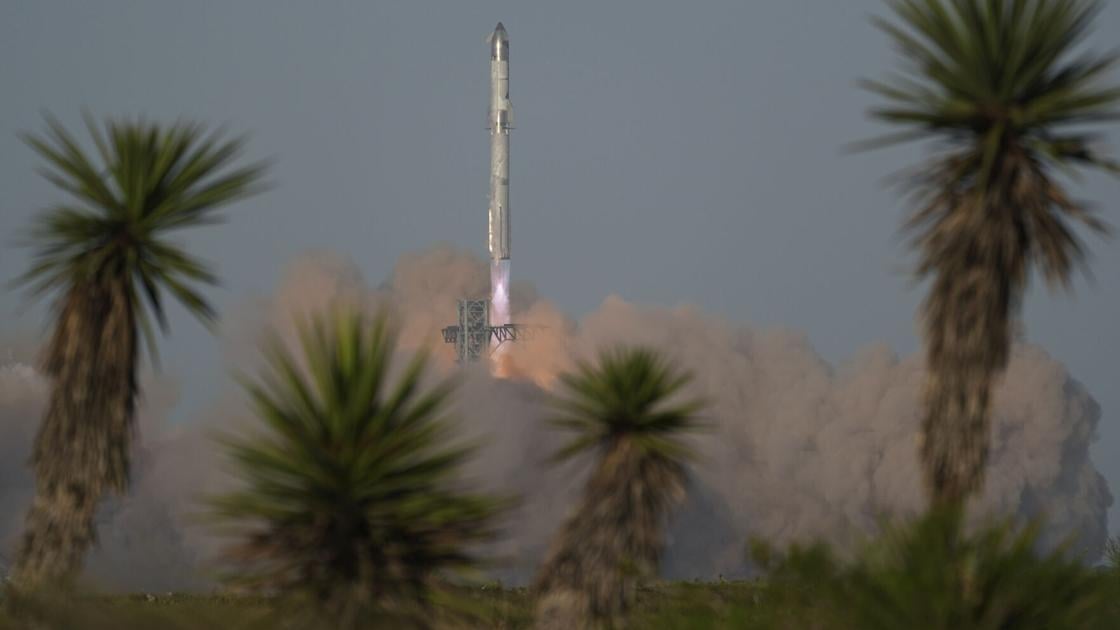Elon Musk’s Starship could one day streak through the skies above parts of Southern Arizona — and cause minor delays at some local airports in the process.
A portion of the state south of Tucson is included in the possible return-flight safety corridor for SpaceX’s latest launch vehicle, according to a federal review of future test flights by the private aerospace developer.
To demonstrate its fully reusable launch technology, SpaceX plans to send Starship into orbit using its Super Heavy rocket booster, then recover both the booster and the spacecraft in a pair of precise, vertical landings back at the company’s Gulf Coast launch facility at the southern tip of Texas.
Starship would reenter the atmosphere over the Pacific Ocean and descend across northern Mexico on a trajectory that would avoid major population centers but require temporary airspace closures and flight disruptions along a path stretching approximately 4,200 miles.
People are also reading…
A map by the Federal Aviation Administration shows the potential aircraft hazard area along the proposed orbital-return-flight trajectory of SpaceX Starship. Starting as early as next year, the reusable spacecraft could begin reentering the atmosphere over the Pacific Ocean and descending across northern Mexico on its way back to the company’s Gulf Coast launch facility near Brownsville, Texas.
Federal Aviation Administration
Last month, the Federal Aviation Administration released a draft assessment that found no significant environmental impacts from SpaceX’s proposed launch and reentry flight paths. But the FAA analysis did determine that as many as 200 aircraft could face delays of as much as an hour each time Starship returns from orbit. The company is seeking permission to conduct up to 22 such return flights to Texas over the course of a year, all of them during daylight hours.
Though the FAA document does not identify any specific airports or commercial routes that could be impacted, University of Arizona aerospace engineer Roberto Furfaro said the full aircraft hazard area mapped out by federal regulators does extend across a sizable swath of Southern Arizona.
“That means local air routes, particularly those connecting Southern California with Texas and points east, could experience temporary reroutes or short ground stops during Starship return operations,” said Furfaro, director of the U of A’s Space Systems Engineering Laboratory and a professor in the Department of Aerospace and Mechanical Engineering.
Furfaro
Arizona Daily Star files
General aviation flights and military operations, including training missions over the Goldwater Air Force Range, would also be subject to any Starship airspace closures, though Furfaro said private pilots and the military typically have more flexibility to work around such disruptions than commercial airlines do.
“These impacts are intermittent and tied to individual reentry windows, but they highlight how the growing cadence of commercial spaceflight is increasingly intersecting with the busy air corridors over our region,” he said.
The FAA is accepting input on its draft environmental assessment through Oct. 20. The agency is scheduled to hold a virtual public meeting on the document starting at 3 p.m. local time on Oct. 7.
It’s unclear when the new reentry and return flight path over the Sonoran Desert might be put to use for the first time. SpaceX and the FAA did not respond to questions about the specific launch schedule.
SpaceX’s Starship Super Heavy reusable launch vehicle lifts off for a test flight from the company’s Starbase at the southern tip of Texas on March 6.
Eric Gay, Associated Press
In September, the technology news website Ars Technica reported that Starship Super Heavy could attempt its first orbital flight as early as next year, but only if its next two suborbital launches go as planned.
Eventually, Musk hopes to send Starship on crewed missions to the moon and Mars. First, though, his space company must prove its reusable, two-stage, heavy-lift rocket and spacecraft are the reliable, economical launch platforms they were designed to be.
SpaceX’s Super Heavy booster rocket returns to the company’s launch pad in Texas to be successfully captured during a test flight on Oct. 13, 2024.
Eric Gay, Associated Press
SpaceX has been working toward that goal since 2002, using an incremental and occasionally explosive approach involving numerous prototype vehicles and frequent test flights. Of the 10 Starship launches since 2023, five have ended in failure, including the first three this year.
SpaceX did find success during its most recent test on Aug. 26, when all 33 booster engines ignited at takeoff and both the rocket and the spacecraft splashed down at their respective targets in the Gulf of Mexico and the Indian Ocean.
The next test of Starship Super Heavy is set to blast off from the SpaceX Starbase in Texas on Oct. 13.
Whenever the 170-foot-long spacecraft finally makes its first orbital flight, at least one U of A planetary scientist will be scanning the skies during its return.
Vishnu Reddy is a professor at the university’s famed Lunar and Planetary Laboratory and a manager for the International Asteroid Warning Network, a worldwide planetary defense collaboration formed in 2013 at the recommendation of the United Nations. He also helps the Air Force keep tabs on orbiting satellites and space junk.
Reddy
Courtesy of the University of Arizona
Reddy said he has been following the FAA approval process for SpaceX’s new launch and return trajectories, and he is “excited” by the prospect of tracking the reentering Starship from Tucson.
“It should be a neat little project for our students to learn how to do that with our telescopes,” he said.
